Event Details:

(SNI Junior Faculty Candidate)
Abstract: Sensory systems create representations of the natural world by translating external environmental signals into internal patterns of neural activity. These patterns are shaped by complex intercellular interactions whose structure spans many levels of spatial and temporal resolution. The statistical regularities of natural signals provide insight into the characteristics of these patterns, how they emerge at a population level, and why they support efficient behavioral strategies. I will discuss two such examples in the visual system, where techniques from statistical physics can be used to probe the structure and function of neural populations in the context of their natural environment. In one example, we show a detailed quantitative match between the statistical structure of natural scenes and human perceptual sensitivity to visual features. In another, we use the structure of natural scenes to probe the detailed features of the neural code in the sensory periphery, which ultimately supports such downstream visual sensitivity. I will conclude by highlighting how these approaches illuminate a broad set of questions about emergent phenomena in neural systems.